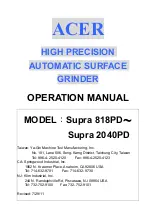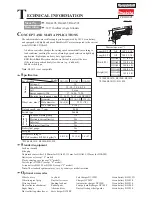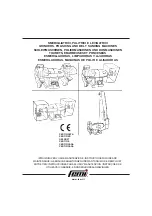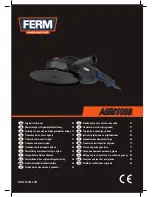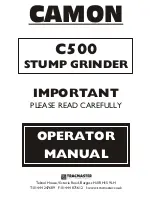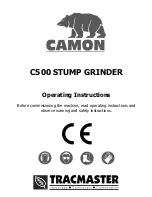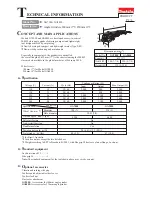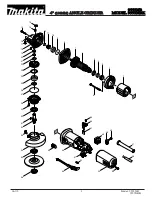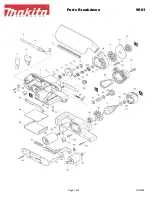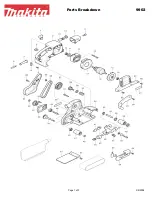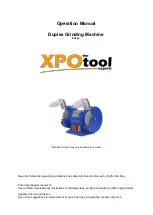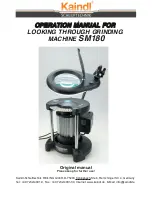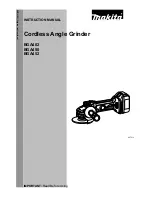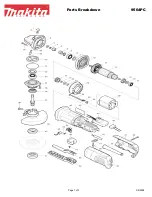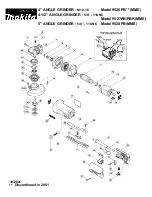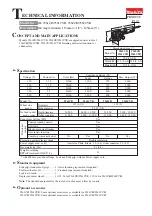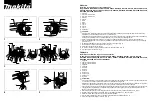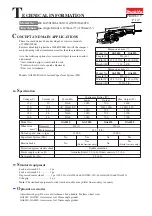
B. SEGURIDAD AMBIENTAL
1. La pintura se deberá quitar de un
modo que minimice la cantidad de
polvo que se genere.
2. Las áreas donde se esté quitando
la pintura deben sellarse con
coberturas plásticas de 4 mils
de grosor.
3. El lijado se debe realizar de un
modo que reduzca el traslado del
polvo de pintura fuera del área
de trabajo.
C. LIMPIEZA Y DESECHO
1. Todas las superficies del área de
trabajo deben aspirarse y limpiarse
por completo a diario durante el
proyecto de lijado. Las bolsas de
filtro de la aspiradora deben
cambiarse con frecuencia.
2. Los paños cobertores de plástico
deben juntarse y desecharse con
todos los restos de polvo y demás
residuos. Deben colocarse en
receptáculos sellados para basura
y desecharse mediante los
procedimientos de recolección
de basura normales. Durante la
limpieza, los niños y las mujeres
embarazadas deben mantenerse
alejados del área inmediata
de trabajo.
3. Todos los juguetes, muebles
lavables y utensilios que usen los
niños deben lavarse muy bien antes
de volver a usarlos.
Ensamblaje
INSTALACIÓN DEL MANGO
LATERAL
1. DESENCHUFE LA RECTIFICADORA.
2. Instale el mango lateral
atornillándolo al costado de la caja
de engranajes.
Nota:
el mango se puede instalar del
lado izquierdo, derecho o superior de
la rectificadora, según la preferencia
del operador. EL MANGO LATERAL
DEBE USARSE SIEMPRE PARA EVITAR
LA PÉRDIDA DE CONTROL Y POSIBLES
LESIONES GRAVES.
3. Ajuste el mango lateral de modo
seguro.
INSTALACIÓN DE LA RUEDA
ABRASIVA
Se proporciona una protección para la
rueda con la herramienta.
Utilice siempre una protección
aprobada y correctamente ajustada
para la rueda cuando use esta
herramienta.
1. DESENCHUFE LA RECTIFICADORA.
2. Coloque la herramienta dada
vuelta con el vástago hacia arriba.
3. Coloque la protección en el reborde
de montaje. Gire la protección
hasta una posición que ubique la
protección entre el operador y la
rueda abrasiva. Ajuste el tornillo de
fijación para asegurar la protección
en la posición correcta.
Asegúrese siempre de que la protección
de la rueda esté entre el operador y la
rueda, de modo que las lascas o trozos
de rueda que se puedan desprender
sean desviados lejos del operador.
INSTALACIÓN DE LAS RUEDAS
ACCESORIAS
1. DESENCHUFE LA RECTIFICADORA.
No desenchufar la rectificadora puede
hacer que se encienda accidentalmente
causando lesiones graves.
2. Su rectificadora se envía con el
reborde del disco y la tuerca de
sujeción conectados al vástago.
3. Presione el botón de bloqueo del
vástago y gire la tuerca de sujeción
hasta que se bloquee el vástago.
Para evitar dañar el vástago o el
bloqueo del vástago, siempre deje
que el motor se detenga por
completo antes de enganchar
el bloqueo del vástago.
4. Afloje y quite la tuerca de sujeción
del vástago. NO quite el reborde
del disco.
5. Coloque la rueda accesoria sobre
el vástago.
!
ADVERTENCIA
!
ADVERTENCIA
!
ADVERTENCIA
Instale siempre la rueda abrasiva
y el disco de paño abrasivo con el
centro rebajado contra el reborde del
disco como se muestra anteriormente.
De lo contrario hará que la rueda
abrasiva se quiebre cuando ajuste la
tuerca de sujeción. Esto puede resultar
en lesiones personales graves ya que
las partículas flojas pueden
desprenderse y ser lanzadas desde la
rectificadora. No apriete en exceso.
6. Para instalar la rueda abrasiva
y el cepillo circular de alambre:
enrosque la tuerca de sujeción en
el vástago con el lado plano de la
tuerca hacia arriba. Calce la parte
elevada, de diámetro pequeño de la
tuerca de sujeción en el orificio de
la rueda y ajústela con la mano.
7. Para instalar el disco de paño
abrasivo: enrosque la tuerca de
sujeción en el vástago con el lado
plano de la tuerca hacia abajo.
Ajuste con la mano.
8. Oprima el botón del bloqueo
del vástago y gire la rueda hacia
la derecha hasta que el vástago
se tranque en la posición.
9. Ajuste la tuerca de sujeción de
modo seguro con la llave que se
proporciona. No apriete en exceso.
Las cerdas del cepillo circular de
alambre se doblarán durante el uso
y mostrarán su dirección de rotación.
Cuando vuelva a usar el cepillo circular
de alambre, móntelo siempre en la
misma dirección que el uso anterior.
De no seguir esta advertencia, las cerdas
se podrán romper y la vibración extrema
del cepillo circular de alambre podría
ocasionar lesiones personales graves.
MONTAJE DE LA RUEDA
DE CORTE
Las ruedas de corte incluyen ruedas
de diamante y discos abrasivos.
Hay disponibles ruedas abrasivas
de corte para metal y hormigón.
También se pueden usar discos de
diamante para cortar hormigón.
No se incluye una protección
cerrada de la rueda de corte con esta
herramienta. Las ruedas de corte
exigen rebordes y protecciones
adecuados. Hay una protección para
corte disponible como accesorio
e incluye rebordes correspondientes
adecuados. No usar los rebordes y
protecciones adecuados podrá resultar
en lesiones debidas a la rotura de la
rueda y al contacto con la rueda.
!
ADVERTENCIA
!
ADVERTENCIA
!
ADVERTENCIA
17 Sp
Figura 1
DG471500CK
Assembly
(Cont’d.)
operator and the grinding wheel.
Tighten clamp screw to secure the
guard in proper position.
Always make sure
the wheel guard is
positioned between operator and the
wheel, so that flying chips or pieces of
a wheel that might break will be
deflected away from the operator.
INSTALLING ACCESSORY WHEELS
1. UNPLUG YOUR GRINDER.
Failure to unplug
your grinder could
result in accidental starting causing
serious injury.
2. Your grinder is shipped with the
disc flange and clamp nut attached
to the spindle.
3. Depress spindle lock button and
rotate clamp nut until spindle locks.
To prevent damage to the spindle
or spindle lock, always allow motor
to come to a complete stop before
engaging spindle lock.
4. Loosen and remove clamp nut from
spindle. DO NOT remove disc
flange.
5. Place the accessory wheel over the
spindle.
Always install
grinding wheel and
abrasive mop disc with the depressed
center against the disc flange as shown
above. Failure to do so will cause the
grinding wheel to crack when
tightening the clamp nut. This could
result in serious personal injury
because of loose particles breaking off
and being thrown from the grinder. Do
not overtighten.
6. To install grinding wheel and wire
wheel brush: Thread the clamp nut
on the spindle with the flat side of
nut facing up. Fit raised, small
diameter portion of the clamp nut
into the hole in the wheel and
finger tighten.
7. To install abrasive mop disc: Thread
the clamp nut on the spindle with
the flat side of nut facing down.
Finger tighten.
8. Depress the spindle lock button and
rotate the wheel clockwise until the
spindle locks in position.
9. Securely tighten the clamp nut with
the wrench provided. Do not
overtighten.
!
WARNING
!
WARNING
!
WARNING
Wire wheel brush
bristles will bend
during use and show their direction of
rotation. When reusing the wire wheel
brush, always mount it to rotate in the
same direction as in prior use. Failure to
heed this warning can result in bristle
breaking and extreme vibration of the
wire wheel brush that could result in
serious personal injury.
MOUNTING CUTTING WHEEL
Cutting wheels include diamond
wheels and abrasive discs. Abrasive
cutting wheels for metal and concrete
use are available. Diamond blades for
concrete cutting can also be used.
A closed, cutting
wheel guard is not
included with this tool. Cutting wheels
require proper flanges and guards. A
cutting guard is available as an
accessory and includes proper,
matching flanges. Failure to use proper
flange and guard can result in injury
resulting from wheel breakage and
wheel contact.
1. UNPLUG YOUR GRINDER. Before
reconnecting the tool, depress and
release the trigger switch to ensure
that the tool is off.
2. Open the guard latch, and align the
lugs with slots on the gear case
cover. Position the guard facing
backward.
3. Push the guard down until the
guard lug engages and rotates
freely in the groove on the gear
case hub.
4. Place the wheel on the backing
flange, centering the wheel on the
backing flange pilot.
5. Install the clamp nut, ensuring that
the wheel remains centered on the
backing flange.
6. Depress the spindle lock button and
tighten clamp nut with wrench.
7. Reverse the above procedure to
remove the wheel.
8. Rotate guard into desired working
position.
!
WARNING
!
WARNING
Operation
Safety
glasses must be worn
during operation.
Make sure work is
held securely in
vise or clamped in place prior to
starting operation. Loose work may
spin and cause bodily injury.
Be certain wheel guard and auxiliary
handle are installed. Firmly grip the
auxiliary handle and motor housing.
Lift up rear of motor housing so that
only the front section of grinding
wheel contacts the work. Use light
pressure. Always lift the grinder off
work before starting or stopping
motor. The arrow on the front gear
housing indicates the direction in
which the grinding wheel rotates.
GRINDING, SANDING, BRUSHING
Always carefully select and use
grinding wheels that are
recommended for the material to be
ground. Make sure that the minimum
operating speed of any accessory
wheel selected is not less than 11,000
RPM.
The grinding wheel provided with your
grinder is suitable for grinding welds,
preparing surfaces to be welded,
grinding structural steel, and grinding
stainless steel. The wire wheel brush is
suitable for removing paint or rust
from metal surfaces. The abrasive mop
disc is suitable for sanding flat metal or
wood surfaces.
Never use your
grinder with the
guard removed. This tool has been
designed for use ONLY with the guard
installed. Attempting to use grinder
with guard removed will result in loose
particles being thrown against the
operator resulting in serious personal
injury.
!
DANGER
!
CAUTION
!
WARNING
4
www.chpower.com
Operating Instructions and Parts Manual
Informaciones
Generales de
Seguridad
(Continuación)











